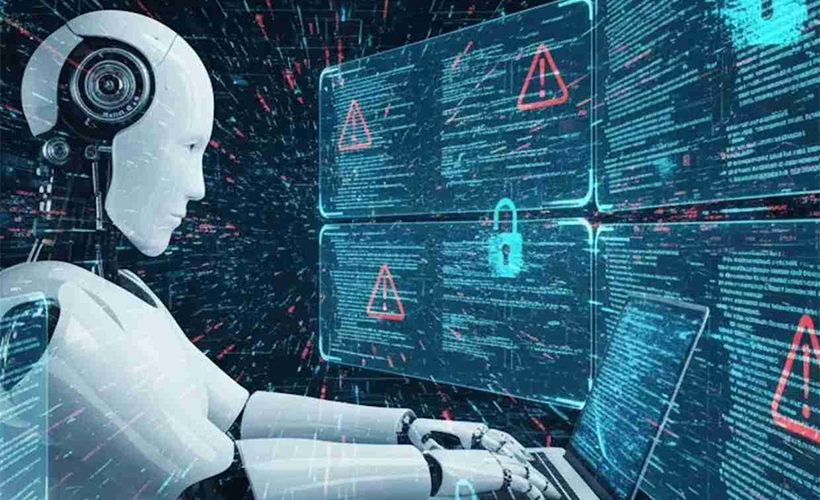
How Cybercrime Got Industrialized — and Turned AI Into Its Deadliest Weapon
Cybercrime: Deadliest weapon: “It’s no longer a question of if you’ll be hacked—but when.”
From ransom demands for blocked websites to demands for “copyright infringement” for publishing photos in the public domain. From blackmail with the threat of publishing intimate photos to direct threats against children. And much more…
Half a million new online threats appear every day. Organized gangs have spokespeople, blogs, and marketing teams. Malware now writes and deploys itself using artificial intelligence. According to cybersecurity expert Gabriel Zurdo, the digital underworld has matured into a fully fledged industry—one where criminals have the upper hand.
Between 400,000 and 500,000 fresh vulnerabilities—many unknown even to tech manufacturers—surface daily across global networks. Once detected, patching a flaw can take up to two years. Meanwhile, only one in four cybercrimes ever gets reported. Welcome to the era of the digital “polycrisis.”
From Defense to Damage Control
“The world used to build defenses to avoid being hacked,” says Zurdo, founder of BTR Consulting. “Now the key question is how to prepare and react when the attack inevitably happens.” His assessment is grim but realistic: attackers are moving faster and smarter, while defenders struggle to catch up.
According to BTR, malware stole more than a billion digital credentials in 2024 alone. The U.S. Federal Trade Commission recorded $12.5 billion in cyber fraud losses that same year—an average of $9,000 per victim.

According to BTR, malware stole more than a billion digital credentials in 2024 alone.
Crime Goes Corporate
The lone-wolf hacker in a basement has evolved into a transnational criminal conglomerate. These digital cartels trade personal data like raw commodities. “Your email, your phone number, your bank account, your location, your social networks—they can bundle your entire digital life as if it were an intelligence dossier,” Zurdo explains. “And yes, it’s for sale.”
Artificial intelligence has supercharged this black market. A notable example is the Brazilian malware Mekotio: it infects devices, disables antivirus programs, identifies online banking platforms, and clones websites. What used to require human operators is now managed by autonomous bots. The result? More victims, hit faster than ever.
Microsoft reports confirm the scale of this acceleration: cyberattacks involving AI have multiplied tenfold between 2023 and 2025.
Ransomware With PR Departments
Ransomware—data kidnapping for ransom payments—rose by 20% in 2024, accounting for 41% of successful attacks. What’s new isn’t just the growth but the organization. Today’s ransomware groups run blogs, publish stolen data, and even employ negotiators. Extortion has become a business process.
Their playbook is meticulous: infiltrate weeks in advance, map systems, copy files, then encrypt and demand payment—usually within 72 hours in cryptocurrency. If victims refuse, data goes public. Some gangs now contact the hacked company’s clients directly: “We’ve got your information. If they won’t pay, you can—so we won’t leak your data.”
BTR notes that three out of four organizations will suffer repeated attacks in 2025. The challenge is anonymity: no one knows who these cybercriminals are, what their names are, or where they operate. They exist beyond borders—and beyond the reach of law.

The challenge is anonymity: no one knows who these cybercriminals are, what their names are, or where they operate. They exist beyond borders — and beyond the reach of law.
The Young and the Unprotected
The most alarming victims may be children. Around 65% of parents hand a smartphone or tablet to their kids by age five. By age eleven, most are intensive users. By nine, many have already encountered explicit online material.
Australia has banned social networks and gaming platforms for under-13s in schools, but experts call such moves insufficient. Parental controls barely work; kids see digital life as normal. Only one in ten raises the alarm when something suspicious happens online.
Humans: Still the Weakest Link
Despite sophisticated tools, humans remain the most vulnerable point in the system. Sixty-one percent of users reuse the same password everywhere. Social engineering—the updated “con man” in digital form—still proves devastatingly effective.
Artificial intelligence amplifies the problem. Gone are the days when phishing emails gave themselves away through clumsy grammar. Today, AI writes impeccable Spanish and adjusts slang and tone to match the recipient’s location.
BTR Consulting, which calls itself “agnostic and independent,” conducts cyberattack simulations for senior executives—training them on what to do when, not if, the breach comes.

Today, AI writes impeccable Spanish and adjusts slang and tone to match the recipient’s location.
Lawless Territory
Cybercrime’s transnational nature collides with outdated legal systems. “Right now, there’s no real law,” Zurdo says. “If an Argentine farm company is hacked by a Russian gang—what legislation applies?” National criminal codes weren’t built for crimes that happen everywhere and nowhere at once.
Fear of reputational damage worsens the silence. Banks, credit card companies, and even multinationals often choose secrecy over disclosure. The result: an unmeasurable, submerged universe of crime.
Even tech giants aren’t immune. CrowdStrike, one of the top cybersecurity tools, was itself hacked. In October 2025, Amazon Web Services went down for a full day—interrupting 2,000 companies and triggering 20 million complaints. Amazon’s contingency plan? None.
Beyond Technology
Experts argue that technology alone can’t save us. “If money solved cybersecurity, the best-funded companies wouldn’t be getting hacked,” Zurdo remarks. The real defense lies in human intelligence—combining foresight, expertise, and strategy.
Still, one warning resonates above all: cybercrime is evolving at unprecedented speed. No firewall or AI model can keep up forever. The only foolproof defense, says Zurdo, “is disconnection.” And in 2025, that’s no longer an option for anyone.
Links
- Cyber Criminals Turn AI Into A Weapon For Hacking As Attacks Surge 47% Globally – Tech Business News
- Scammers clone persons’ faces to steal information – iGotOffer
- Sell your pre-owned AI device online – iGotOffer
How artificial intelligence is ushering in a new era of cybercrime [Video]
Video uploaded by CBS News on August 7, 2025.






Facebook
Twitter
RSS